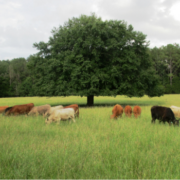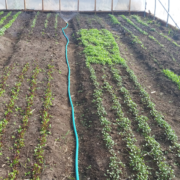Soil Social: Quorum Sensing, Part 2
 Print This Post
Print This Post
By Darron Gaus, NCAT Agriculture Specialist
Returning to the vacuum silenced, golden morning hours on the farm, where you now listen intently for the soil social beneath your feet, your senses are becoming more aware of the microbiology community that you steward. Now your thoughts drift purposely between water, carbon, and nutrient cycles that the biological community in your soil manage. Questions begin to formulate in your head. How can you tell if quorum sensing is occurring? What steps can be taken to maximize efficiency of the quorum sensing process? In Part 1 of this series, I discussed the process of quorum sensing. These questions, and certainly many others, need further detail.
A tangible event that illustrates the quorum sensing process might be familiar to most readers. Strep throat. Streptococcus bacteria are inside of us more often than we think, but in small numbers. When the population has grown in a nourishing environment to the size needed for gene expression or protein creation, that is when we begin to wince at every swallow and run fever. A bacteria that was always present needed a population big enough to reach a quorum consensus to turn on its ability to create an infectious disease. The symptoms we feel are how we know the process occurred.
The profound complexity of microbiology in the soil and plants can use quorum sensing to create infectious disease, protect from disease, invite pollinators, invite predators, stimulate root growth, or create multitasking biofilms, as discussed in Part 1. Knowing when all this silent communication occurs in the soil is not as easy as diagnosing a sore throat. Farmers and ranchers must use keen, regular observation to investigate and evaluate quorum sensing.
In rangeland, as healthy soil indicators arise, fungal and bacteria ratios begin to change. Native perennials begin to return. Observing strips of natives returning to the landscape is a certain sign of quorum sensing at work. The seeds for these natives were present in the seed bank for a long time. However, the right environment wasn’t. When environmental cues begin to shift the fungal and bacteria communities, quorum messages network out to create proper germination stimulants that the seed bank has been absent of. These observed strips mean that the environment is exactly right for this quorum sensing to occur. The journey to growing this conducive environment to incorporate larger areas of your landscape may be long, but it’s well worth the resiliency potential in your farming or ranching operation.
In cropland or vegetable production, a way to observe quorum sensing is observing the presence of pollinators and predatory insects. If one day you notice aphids attacking your crop, your healthy soil’s mycorrhizal fungi will send messages to create volatile organic compounds (VOCs) to attract ladybugs and other beneficial predators to perform pest control for you. This is a great sign of quorum sensing and your soil’s ability to care for itself. These VOCs created by fungi signaling also occur to attract pollinators just before blooms open on vegetable plants. Small observations that mean big moves in soil health and biological quorum sensing.
Providing the optimal environment and feeding your soil is the start of maximizing the soil potential of quorum sensing. Water, carbon, and nutrients are all building blocks for the microbiological community. Learn more about creating a drought and flood-resistant soil sponge with the resources from Soil for Water. There are many resources from ATTRA on the topics of water, fertility, compost, and biochar.
If these steps to feed the soil are utilized, quorum sensing will be happening all around. It is up to your ability to read the land and recognize successes and failure as part of your daily routine. Next time the dawn brings forth the silent moments, use them to observe and record all the evidence that quorum sensing may be occurring.
Use the ATTRA forum to discuss some of these observations with your peers. Hear about what they are seeing as well. Utilizing peer-to-peer networks can increase your ability to look for things that you may not have noticed before, like the earned results of quorum sensing in fertile soils.
This blog is produced by the National Center for Appropriate Technology through the ATTRA Sustainable Agriculture program, under a cooperative agreement with USDA Rural Development. ATTRA.NCAT.ORG.












